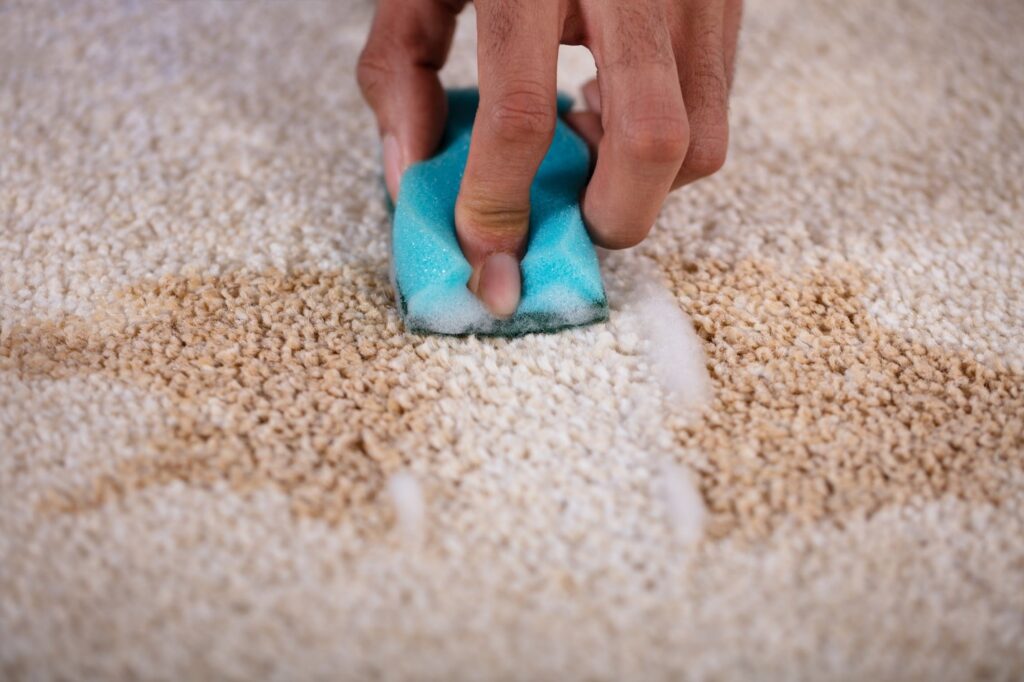Carpet stains come in a variety of shapes and sizes. Some carpet stains are permanent, while others may be removed with a carpet stain removal treatment. The best strategy for carpet stain removal depends on the type of stain you’re dealing with. We’ll go over numerous types of typical household carpet stains and how to treat them in the next post.
There are some DIY methods for carpet stain removal in some instances, but for the best results, rely on professional deep cleaning by qualified and experienced specialists using professional-grade equipment and cleaning products.

Three Questions Regarding Your Carpet Stain
Before offering any advice, we ask three questions when asked how to remove a stain or whether a spot from a recent spill would come out.
1. What Caused the Stain in the First Place? Did it come from an organic or non-organic source?
ORGANIC STAINS are caused by natural elements. Consider food, biological fluids, soil, and so on. Organic stains are usually easier to remove than non-organic stains. You can usually clear up the stain with ordinary water, especially if you have a carpet protector put at every professional cleaning of your carpet. Additional treatments may be necessary for older stains or harsher stains like mustard or coffee.
MAN-MADE OR MANUFACTURED PRODUCTS CAUSE NON-ORGANIC STAINS. Non-organic stains are caused by oil-based materials such as ink, nail polish, hair color, shoe polish, slime, makeup, and so on.
What to Remember: Some stains are impossible to remove even with a carpet stain removal service. Laundry is the same way. Consider a white shirt with a mustard stain. The chances of such happening are extremely minimal. If only we could tye-dye our carpets when they get stained like we can our favorite white shirt when it gets damaged on spaghetti night. Carpets and fabrics can be dyed and color adjusted.
2. Has the stain been on your carpet for a long time?
We want to know how long ago the accident/spill happened so we can see how fresh the stain is, if it’s been exposed to foot traffic and if there have been multiple spills/accidents on top of each other. We’d like to know whether it’s moist, dry, or crusty. This leads to the next point.
3. How have you done carpet stain removal so far?
What product did you use and what was the name of it? Spotters for carpets, laundry detergent, oxygen-based products, bleach, nail polish remover (acetone can remove the color), baking soda…
This reveals the stain’s current state as well as the path it has taken. Many operations might cause more harm than good, and knowing what you’ve already done is an important component in deciding what to do next. Another thing to consider is that getting chemical reactions via a combination of approaches isn’t unheard of.
Let’s start with the essentials now that we know what we’re dealing with. Before we start treating the spot/stain, we’ll go over what not to do.
When it comes to rugs and carpet stain removal, there are a few things you should avoid doing.
Call a professional, licensed cleaner if you are simply not comfortable or confident in addressing the stains on your carpet.
- If you look for DIY carpet stain removal in Melbourne remedies on the internet, you’ll get a lot of different ideas. Not to mention all of the big brands that advertise spot removal in a can with no worries. The truth is that you should be cautious about what you place on your carpet. One thing to keep in mind is that everything you put on the carpet should be removed.
- If you don’t have a technique to flush and extract the carpet, don’t expect miracles by saturating it in soap, cleanser, or spotter.
- Use only one product/DIY approach at a time. Stop and call a professional, qualified cleaner if it doesn’t come out the first time.
- Avoid using over-the-counter carpet spotter solutions/sprays at any time. The majority of them leave an excessive amount of soapy residue, which draws more soil over time. Other spotters, such as oxygen bleach cleansers, should be used with caution and should never be used on silk. These have the potential to stain your carpet or fabrics.
- Never massage the affected area. Although it may seem natural, never rub the strands because this will damage them and make them appear frayed. You also run the danger of the spot spreading to a broader area.
- If you must use a cleaning, even diluted dish soap, do it sparingly. More soap will not speed up the cleaning process. The more soil-attracting residue will be left in the carpet fibers as a result.
- Never remove nail polish with nail polish remover.
When it comes to rugs and carpet stain removal, there are a few things to keep in mind.
- Always try to use a clean white towel in the event of an emergency spill or to get an old crusty spot out of the carpet (CWC). You won’t have to use a towel that can end up transferring color to your carpet this way. If you don’t have a CWC, make do with what you have. Always keep in mind that time is crucial when it comes to efficiently treat a spill.
- Remove any excess substance from the carpet first if you have a spill. Remove as much of the solids as possible before blotting. Use what you can to peel away the dried substance if the location is dry and crusty. A dull plastic putty knife or the back of a spoon might work fine. Whatever it takes: a plastic spatula, a remote control, your children’s toys, and your husband’s comb 😉 It may be necessary to use a steel brush or something more elaborate in some cases. Just be cautious and mindful of the potential for harm. Keep in mind that spot removal is an attempt to restore something that has already been harmed. You can usually improve things, but you can also end up causing more long-term harm.
Next, decide on the best treatment strategy for you. Knowing a little bit about the carpet’s history and evaluating its condition. From the options below, choose A or B.
- The carpet is new or has recently been professionally cleaned and protected. The protector is designed to aid in the carpet stain removal from fibers.
To avoid spreading the spot, use a dry CWC to blot it from the outside in. Blot the spot with all of your body weight and rotate the CWC to a clean location.
Rinse and wring the fabric until there is no longer any transfer of the spot to the cloth or there are no clean regions left on the cloth.
Blot the spot with a moist CWC in the same manner as before.
Use a wet vacuum system to extract if you have one. To acquire some clean water in the area, use a more-than-damp CWC. The fibers will be flushed after extraction.
- If the spot/stain persists after attempting Option A and the carpet has not been cleaned and preserved lately.
In a quart of water, dissolve 1/4 teaspoon clear dish soap.
Wet a CWC and blot the place from the outside in with the water/soap combination.
Use a wet vacuum system to extract if you have one.
Always “rinse” the place with plain water after using any type of soap or surfactant. Fill a new CWC with clear H2O and dampen it. Several times blot and extract the spot. To acquire some clean water in the area, use a more-than-damp CWC. The fibers will be flushed after extraction.
Keep this page open in case you have a carpet stain removal emergency.
Always have carpet protectors reapplied after having your carpet professionally cleaned to extend the life of your carpet and provide you more time in the event of a spill.






